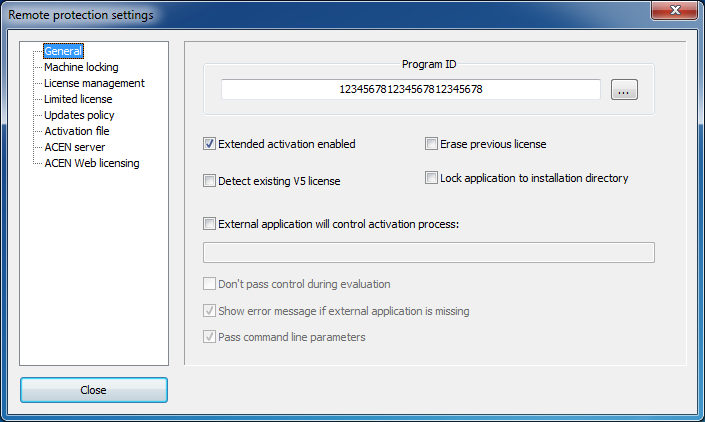
Program ID
Program ID is 96bit hexadecimal value which is used for application encryption in remote protection method.
- It's 24 characters long and may contain 0-9 numbers and A-F letters just like any other hexadecimal number.
- You can set Program ID manually or let PC Guard automatically generate random Program ID by clicking on '...' button in general remote protection settings.
- Program ID is not stored into protected application during protection process.
- Valid Program ID is required for generation of activation codes.
- Please see Application signature notes for more information related to Program ID.
Extended activation enabled
If this option is enabled, extended activation dialog will automatically be displayed in activation panel. (Default status: OFF)
Detect existing V5 license
If selected, protected application will try to detect and use existing active license of application protected with with same project settings (application signature and program id) but with previous version of PC Guard family products (V5). (Default status: OFF)
- This option is useful in case license reactivation should be avoided for free application updates for applications originally protected with PC Guard V5 family products.
- Check for existing V5 license is done only once during the first run of protected application on remote machine.
- If existing V6 license is detected on remote machine application protected with this option enabled will not check for V5 license at all.
- If V5 license is detected but not active (application is in demo mode or in locked state) it will be ignored.
- If active V5 license is detected, protected application will automatically activate itself. No further V5 licenses checks will be done on remote machine after this. V5 license will stay intact and independent from V6 license. This means that end user will be able to continue using both V5 and V6 licensed products on same machine. All future V6 license changes will not affect V5 license on same machine and vice-versa.
Erase previous license
Protected application will erase previously activated license of same application (protected with same application signature) on remote computer. (Default status: OFF)
NOTES:
- Be sure to increase Update ID when enabling this option. All updates are identified by Update ID value.
- License will be reset only in case Update ID is higher then existing Update ID (old update can not reset license of newer update).
- Protected application will generate different Site/MID codes and ask for new activation code.
- Limited license feature parameters will be reinitialized with currently set limitations for this update.
Lock application to installation directory
If selected, protected application will be locked to its installation directory after activation. (Default status: OFF)
Installation directory is considered as directory in which the program was located at the time of activation. Once activated, application can not be moved and run from different directory.
NOTE:
If you are using the same application signature for a group of programs and you still want to enable this option, please note that you should keep all programs in same directory in this case.
External application will control activation process
If enabled, protection code will pass control to another application (which would handle activation process) and exit. (Default status: OFF)
"Don't pass control during evaluation" option. (Default status: OFF)
Enable this option to prevent passing control to external application during evaluation period.
"Show error message if external application is missing" option. (Default status: ON)
If selected, protected application will show error message if not able to run external application.
If not selected, protected application will just silently exit.
"Pass command line parameters" option. (Default status: ON)
If selected, protected application will pass command line parameters to external application.
NOTES:
- External application should be located in same directory as protected application.
- This option can be useful for applications without technical ability for using protection interface. For example, such application would pass control to another application which can use protection interface and take full control over activation process.